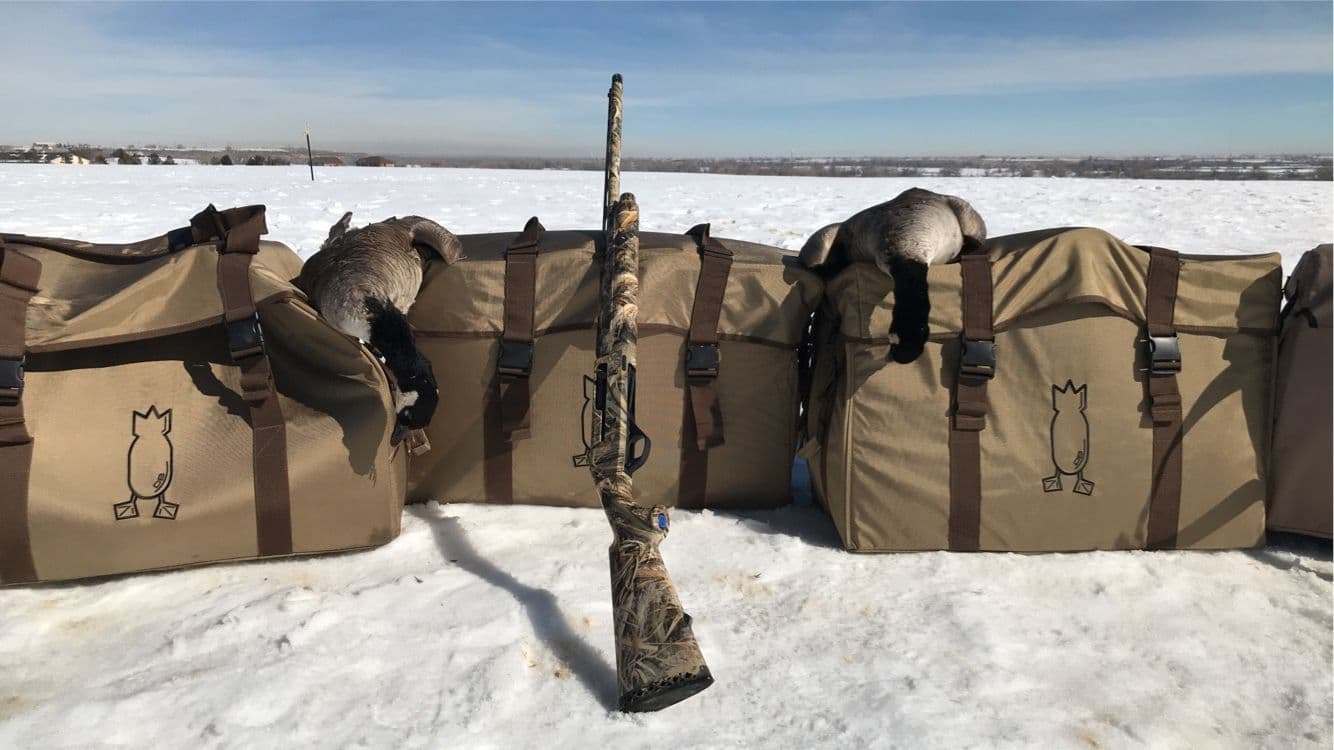20 Gauge vs 12 Gauge for Duck Hunting: Choosing the Right Gauge for Your Waterfowl Hunt


Justin Hunold
11/05/2024
When picking a shotgun for waterfowl hunting, the debate between the 20 gauge and the 12 gauge often finds hunters choosing sides. Both gauges have their advantages and disadvantages, and recent advances in non-toxic shotshell technology have changed the game—especially for the 20 gauge. Whether you’re a seasoned duck hunter or getting ready for your first season, understanding what both gauges offer and how they align with your hunting style can make a big difference. Let’s break down the pros and cons of each and explore how modern, non-toxic shotshells are changing the playing field.
12 Gauge: The Classic Workhorse
The 12-gauge has long been the standard for waterfowlers. With its power and versatility, many waterfowl hunters traditionally opt for this gauge. A 12 gauge offers higher shot capacity and energy (more ounces of payload), making it a solid choice for reliably downing ducks, especially at longer distances. Here are the pros and cons of hunting ducks with a 12 gauge:
Pros of Using a 12 Gauge
Increased Power and Range: With more powder and a larger payload, the 12 gauge offers greater range and stopping power, making it ideal for long-distance shots over open water. This is especially important when focusing on steel shot. When using steel, larger shot sizes are needed to carry momentum over a long distance to down tough birds.

Variety of Shotshell Options: The 12-gauge has the broadest selection of ammunition, including steel, bismuth, and tungsten non-toxic options. Variety isn't just the shot composition but also the payload. A 12-gauge shell has more space for heavier loads of bigger-size shots, but you can also trim down the shot count for lighter loads. This variety allows hunters to tailor their setup to specific conditions and hunting scenarios.
Versatile Load Options: The 12-gauge can handle a range of shot sizes and payloads, allowing hunters to adjust for large geese and swans or smaller waterfowl like puddle ducks and divers with the same shotgun.
Cons of Using a 12 Gauge
Heavier Recoil: A 12 gauge typically has more recoil, which can be harsh on some hunters, especially those who prefer lighter guns for quicker shots in fast-paced situations.
Weight and Bulk: Many 12-gauge shotguns are heavier and bulkier than their 20-gauge counterparts, which can be a drawback for hunters who walk long distances to find their spot or prefer quicker mobility.
20 Gauge: The Lightweight Challenger
The 20 gauge has gained popularity as a waterfowl hunting option, especially with the rise of advanced non-toxic shotshells like tungsten and bismuth. These developments have allowed hunters comparable stopping power from a smaller, lighter gauge. The 20 gauge appeals to those who want a more nimble, low-recoil gun without compromising too much on performance.
Pros of Using a 20 Gauge
Lower Recoil: The 20 gauge has significantly less recoil, making it a gentler option for new hunters, young shooters, or anyone who values comfort fro volume shooting or close encounters like Timber hunting.
Lightweight and Portable: The 20 gauge is often lighter and easier to carry, which can be a significant advantage for hunters who hike long distances or spend hours moving through dense marshes. A 20 gauge just seems to fit in the hand in a way a 12 doesn’t. I’m an average sized guy and find myself using a 20 gauge a lot when hunting big marshes or swamps with long walks.
Improved Handling: Many hunters find the 20 gauge faster and easier to handle, especially when ducks come in fast or when you’re hunting from a tight blind. God made Teal and Wood Ducks to be shot at with a 20. They are just the perfect combination.

Cons of Using a 20 Gauge
Reduced Range and Power: Despite advancements in shotshell technology, a 20-gauge can still fall short at longer ranges than a 12-gauge. This can be a disadvantage in open water setups where ducks may come in from a distance. I prefer my 12 gauges when hunting Divers for this reason. These are tough ducks with occasionally long shots. The 12 offers a margin of error the 20 does not.
Limited Load Options: While the 20 gauge has more non-toxic load options than ever, it doesn’t offer the same variety as the 12 gauge. This can limit versatility for hunters who want to adapt to different conditions or bird species. Not a deal breaker for most duck-hunting situations, but when geese or swans are in the mix, there are shot sizes offered in 12’s that are near impossible to find in 20’s.
The Impact of Modern Non-Toxic Shotshells on the 20 Gauge
Over the past decade, advancements in non-toxic shotshells—especially with materials like tungsten and bismuth—have made the 20 gauge more viable for duck hunting than ever before. Historically, with steel shot, 20-gauge shotguns struggled with range and power, but modern shotshells have closed the gap. Tungsten and bismuth shot pellets are denser than steel, giving them better penetration and knockdown power, even in smaller shot sizes. They act a lot like lead, maybe even better. This means that hunters can now load up a 20 gauge with non-toxic rounds that rival the effectiveness of a 12 gauge, particularly within moderate ranges.
This development has fueled a rise in 20-gauge popularity among hunters looking for a lighter, more maneuverable shotgun without sacrificing efficacy. It also means that recoil-sensitive folks—whether due to age, experience level, or simple preference—can feel confident choosing a 20-gauge shotgun without losing out on performance.
Which Gauge Should You Choose?
Choosing between a 20 gauge and a 12 gauge ultimately depends on your hunting style, the conditions you hunt in, and what matters most to you. Here’s a quick summary to help you make your best decision:
If you prioritize range, power, and versatility, the 12-gauge remains the best choice. It offers a wide selection of shotshell options and can handle a broader range of hunting scenarios. Teal up close, Divers out off a point, Goose hunting from a layout blind, 12 does it all well.
If you prefer lighter recoil, better handling, and portability, a 20 gauge is worth serious consideration. With modern, non-toxic ammunition, the 20 gauge now holds its own for duck hunting, especially when shots are close to moderate range. The 20 shines in marshy or brush-heavy areas where quick handling and mobility are key. 20 Gauges are a gift when birds are dropping into Timber or in tight permanent blind conditions.
Situational Breakdown: When to Use a 20 Gauge vs a 12 Gauge
Every hunting environment and scenario has its own personality and needs. Choosing the right gauge can make a big difference. Here’s a look at some common duck hunting setups and specific conditions, with insights on when each gauge might be the better choice.
1. Flooded Timber
Duck hunting in flooded timber often means shorter-range shots as ducks drop in through the trees. The natural overhead cover limits visibility, making this an ideal situation for a lighter 20 gauge. With the right non-toxic shotshell, a 20 gauge can deliver great knockdown power within the close to mid-range distances in flooded timber. The low recoil and maneuverability are also helpful in these tight spaces where you might be pivoting quickly for a shot.
Best Gauge: 20 Gauge – Ideal for the shorter, reactive shooting distances and easier handling.
2. Layout Blinds in a Field
For layout blinds in open fields, where ducks and geese approach from a distance, the 12-gauge is the go-to. The added power, range, and shot capacity give hunters a longer reach, which can make the difference when birds hesitate to commit fully to the spread. The increased stopping power of a 12-gauge also helps when hunting geese, which often require more knockdown force than a 20-gauge can muster, especially with larger steel shot.
Best Gauge: 12 Gauge – Better suited for longer-range shots and high-flying geese in open fields.

3. Smaller-Framed Hunters
The 20 gauge is often the best choice for younger, smaller-framed, or recoil-sensitive hunters. The lighter weight and reduced recoil allow for easier handling, quicker target acquisition, and overall comfort—especially during long hunts. That reduced weight and bulk makes those hours a bit easier. With high-quality non-toxic loads, a 20 gauge can deliver solid performance without the strain of a 12 gauge’s heavier recoil and the overall bulk of a big gun.
Best Gauge: 20 Gauge – Easier handling and lower recoil make it ideal for smaller or recoil-sensitive hunters.
4. Owning Only One Shotgun for All Situations
If you’re looking for a single shotgun to cover all of your hunting needs, the 12 gauge is the most versatile choice. Its wide range of shotshell options, payload capacities, and ability to handle different hunting scenarios make it the better all-around option. From waterfowl to upland game, a 12-gauge can do it all, making it perfect for those who only want or can afford one shotgun.
Best Gauge: 12 Gauge – Versatility across different hunting types and settings makes it the best single-gun option.
5. Hunting Puddle Ducks
Puddle ducks, like mallards, teal, and pintails, are often found in marshes and other shallow wetlands where shots tend to be close range. A 20 gauge is usually an excellent choice in these environments, providing the flexibility and lighter recoil suited for quick shots in tight quarters. Plus, a 20 gauge allows for a more comfortable experience if you’re wading through or covering long distances on foot.
Best Gauge: 20 Gauge – Excellent for short to moderate-range shots on smaller ducks in wetland areas.
6. Hunting Geese
For geese, a 12 gauge is generally the more effective option. With their larger size, thick fat and muscle and denser plumage, geese can be tougher to bring down. The 12 gauge provides the necessary velocity, momentum, and shot volume to ensure clean kills. Additionally, the heavier payload options available in 12 gauge and modern non-toxic shot materials make it the more reliable choice for goose hunting.
Best Gauge: 12 Gauge—It provides the range and power necessary to handle larger, tougher birds like geese.
7. Hunting Diver Ducks
Diver ducks are known for their speed, resilience, and tendency to dive when injured. Hunting them often involves longer, challenging shots over open water, where the 12 gauge shines. The increased range and shot capacity of a 12 gauge allow for more reliable performance at the distances diver ducks can require. The larger shot size options also help ensure the necessary penetration for a clean hit on these fast-moving birds.
Best Gauge: 12 Gauge – Bang up for diver ducks' longer-range shots and speed in open water setups.
Final Takeaway
Both gauges have unique advantages depending on your hunting environment and the species you’re after. A 20 gauge is about perfect for flooded timber or smaller hunters seeking comfort and maneuverability. The 12 gauge’s power, range, and versatility make it ideal for geese and diver ducks or as a go-to all-purpose shotgun.
Modern non-toxic shotshells continue to bridge the performance gap, Making the 20 gauge every bit as good, if not better, in certain situations. When choosing the 20 gauge, understanding the strengths of each gauge and matching it to your hunting style will ensure the best results.
The decision between a 20 gauge and a 12 gauge is no longer as simple as it once was, thanks to the advancements in non-toxic shotshell technology. With high-quality bismuth or tungsten rounds, the 20 gauge can be as effective for duck hunting as a 12 gauge in many scenarios.
Whether you’re swinging a lightweight 20 or a powerhouse 12, remember that your shooting mechanics, a good understanding of bird behavior and understanding your setup will always play the biggest role in a successful hunt.
The bottom line: Both gauges have earned their place in duck hunting, and each can excel with the right preparation and understanding of their strengths and limitations.